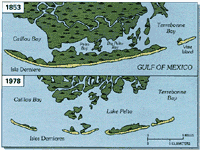
We need to talk. We have a great projects to save land but there seems to be no discussion, either pro or con or what about the future.
How can a brilliant work of engineering and science signal a moment of pride and hope for a state, but also include dire warnings and be missing an essential message? That’s my first reaction to the draft edition of the 2023 Louisiana Coastal Master Plan for a Sustainable Coast, released last week. Teams of world-class scientists and engineers from Louisiana and across the world have produced what is arguably the most advanced science-based coastal resilience strategy in this age of climate change. It is filled with projects such as new levees, floodwalls and wetlands restoration to reduce the growing risks of higher storm surge reaching further inland from ever-growing hurricanes. It lays out plans for removing willing residents outside those protections and helping others to “flood-proof” their homes and businesses. It has interactive online programs that can tell residents what risks they face, what roads might be flooded and how much damage their individual communities could suffer. It estimates the billions in savings these projects offer from what is expected to be more billions in annual losses going forward every year. So where are the dire warnings?
nola.com
One warning is what the cost is needed to help us stay her.
Well, the fact that we now need an announced $50 billion effort ($92 billion when inflation is added) to make the landscape we live on “sustainable” is itself a pretty clear warning. Indeed, the Coastal Protection and Restoration Authority repeatedly states that climate change ensures “Louisiana’s landscape is going to look different 50 years into the future.” And there is this: It’s just a 50-year plan. It makes no promises beyond 2070. In fact, it reports “the benefits of many of the early projects diminish in the final decade as they can no longer keep pace with subsidence and accelerated rates of sea level rise.” It finds that even if the projects work perfectly, we would likely still lose another 767 to 2772 square miles just by 2070. Which leads me to the missed essential message. The CPRA has chosen not to mention the main determining factor for the efficacy of its projects and any sustainable future here: The need for the nation and world to dramatically reduce greenhouse gas emissions over the next 10 to 20 years.
Why is this so? We have a House of Representatives that wants to go back to Drill, Baby, Drill. We are in a state that says emissions emitting plants are welcome as they build jobs.
Here’s why. Reducing risk from sea level rise is the plan’s major concern. It is listed as the key factor in its “low” and “high” scenarios for future flood risk. That increased flooding is due to the record acceleration of sea level rise, which is being driven by greenhouse gas emissions. The National Oceanic and Atmospheric Administration says emission-caused sea level rise could push the Gulf 2.5 feet higher along our coast by 2050 — just 27 years from now — and much more beyond that date. That does not include the added impact as our sediment-starved deltas continue to sink. CPRA says those NOAA projections are in line with the rates it used in coming up with its low and high scenarios for sea level rise. Yet it never mentions the commanding role rising emissions plays in those scenarios. In fact, the words “greenhouse gas emissions” appear on only two pages near the end of the 184-page document. This is in the section labeled “Beyond the Master Plan,” in a chapter on Gov. John Bel Edwards’ Climate Initiative Task Force. True to the science, reducing the state’s emissions footprint is the stated focus of that report and its recommendations.
Emissions we know about as we hear about them daily.
Of course, emissions controls are a topic that remains unmentionable in Louisiana politics, still largely under the financial sway of the oil, gas and petrochemical industries. But saying coastal Louisiana may be on its deathbed due to sea level rise without talking about fossil fuel emissions would be like saying a patient is dying of blood loss without pointing out the cause was a gunshot wound. The brilliant authors of this great plan know full well that there can be no long-term resilience for this coast without dramatically reducing carbon emissions. Their own computers show that. But we can’t get to that solution unless we say it.
Bob Marshall makes a good point but emissions is a topic that some care about and other say so what.



